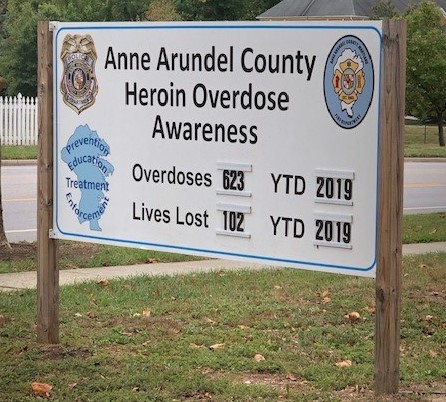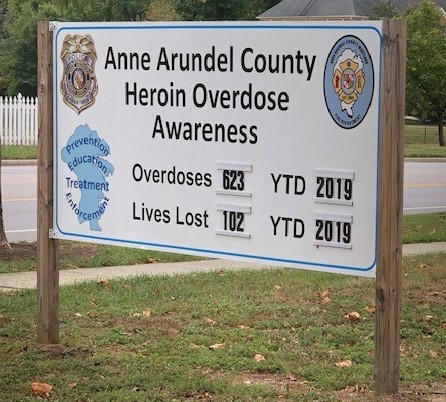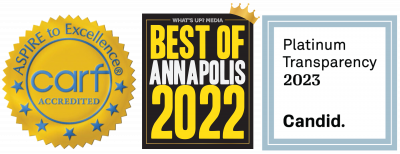
The opioid crisis in America is a growing problem. In Anne Arundel County, the situation does not fare well.
The photo below, taken just outside of the police station in Edgewater on September 13, 2019, shows that in Anne Arundel County alone, 623 community members have overdosed on Heroin, and 102 of those people died this year as a result of an overdose. Just six months ago (March 2019), there were 119 members of the community who had overdosed, with 20 of them resulting in death. This epidemic is affecting the community, and quickly, with these occurrences climbing by almost 20% in only six months.
Unfortunately, community members who experience opioid use disorders typically cannot simply stop using opioids abruptly and it is not always advisable to do so. Stopping “cold turkey,” has a low incidence of recovery success (fewer than 25% remain in recovery for one year) due to intense cravings and withdrawal symptoms. Quitting abruptly can cause seizures, arrhythmia, hallucinations, and other life-threatening medical conditions. That being said, many individuals do overcome opioid addiction and live healthy, productive lives.
Thanks to a $50,000 grant from the Chaney Impact Fund, First Step Recovery Center at Arundel Lodge is expanding their medication assisted treatment (MAT) program. The Chaney Impact Fund is a component fund of the Community Foundation of Anne Arundel County. The mission of the Chaney Impact Fund is to nourish communities in Anne Arundel and Calvert Counties by supporting youth as the foundation for building healthier neighborhoods, today and in the future. One of the funding priorities of the Chaney Impact Fund is mental health and substance abuse treatment. Grants are made to nonprofit organizations that support substance use prevention at the grade school level, treatment, and education. “The Chaney Impact Fund is so proud to support Arundel Lodge’s MAT program. We know substance abuse is an uphill battle, and if this helps to save even one more life, we consider it a success,” says RG Lare, President of the Chaney Impact Fund.
“Addiction changes brain chemistry, so fewer than 25% of individuals who try to stop using opioids ‘cold turkey’ remain in recovery, due to intense cravings and withdrawal symptoms. But 40% – 60% of people who receive a combination of counseling and medication-assisted treatment, do overcome opioid addiction and live healthy, productive lives,” says Mike Drummond, Executive Director of Arundel Lodge. “One particular advantage to helping community behavioral health centers, such as Arundel Lodge, who have longstanding expertise with substance use disorders and mental health treatment, is that the integration of mental health and substance use treatment services helps increase chances of recovery success,” Mr. Drummond adds.
MAT uses a combination of counseling and behavioral health therapy, along using an FDA approved medication combining buprenorphine and naloxone, which curbs cravings, decreases withdrawal symptoms, and reduces the risk of relapse. Additionally, using Suboxone eliminates the need for hospitalization in most cases.
How it works:
Medication-assisted treatment is an important, effective treatment for opioid addiction. The NIH states that “providing for the global availability of medication-assisted treatment (MAT) for opioid addiction is more important than ever.” MAT uses a combination of two drugs, buprenorphine and naloxone. Buprenorphine, a partial opioid agonist, helps in weaning individuals from opioids; Naloxone, an antagonist, alleviates cravings for 24 hours, giving Individuals a fighting chance. MAT treatment happens in three phases:
1. Induction Phase – medically monitored startup of FDA approved buprenorphine products treatment performed in a qualified physician’s office or certified Outpatient Treatment Program. The medication is administered after abstinence from opioids for 12 – 24 hours and the individual is in the early stages of withdrawal.
2. Stabilization Phase – begins after a person has discontinued or greatly reduced their misuse of the problem drug, no longer has cravings, and experiences few, if any, side effects. The buprenorphine dose may need to be adjusted during this phase.
3. Maintenance Phase – starts when a person is doing well on a steady dose of buprenorphine. The length of time of the maintenance phase is tailored to each individual and could be indefinite.
“The most important part of this program is the ability it has to decrease overdoses and essentially save lives,” says Arundel Lodge’s Outpatient Behavioral Health Clinic Director, Leigh Ragan, a Licensed Clinical Alcohol and Drug Counselor.
“The Chaney Impact Fund is contributing to something that is going to make a real difference for individuals and families in our community, and we are grateful for their partnership” adds Mr. Drummond.
Treatments will be done at First Step Recovery Center of Arundel Lodge, located at 1819 Bay Ridge Avenue in Annapolis and at Arundel Lodge’s main campus location, 2600 Solomons Island Rd, Edgewater, MD 21037.
If you or someone you know is in need of Medication Assisted Treatment, contact Leigh Ragan, LCADC at 410.280.2333 ext 1004 or call Arundel Lodge’s main number 443-433-5900.
For resources and to learn more:
(Improving Public Health Through Access to and Utilization of Medication Assisted Treatment, 2011) (Drugabuse.gov, 2016) (SAMHSA, 2019)
Drugabuse.gov. (2016, November). Effective Treatments for Opioid Addiction. Retrieved from Drugabuse.gov: https://www.drugabuse.gov/publications/effective-treatments-opioid-addiction/effective-treatments-opioid-addiction
Lubran, T. K. (2011, October 24). Improving Public Health Through Access to and Utilization of Medication Assisted Treatment. Retrieved from ncbi: https://www.ncbi.nlm.nih.gov/pmc/articles/PMC3210600/
SAMHSA. (2019, May 7). Buprenorphine. Retrieved from Samhsa.gov: https://www.samhsa.gov/medication-assisted-treatment/treatment/buprenorphine


